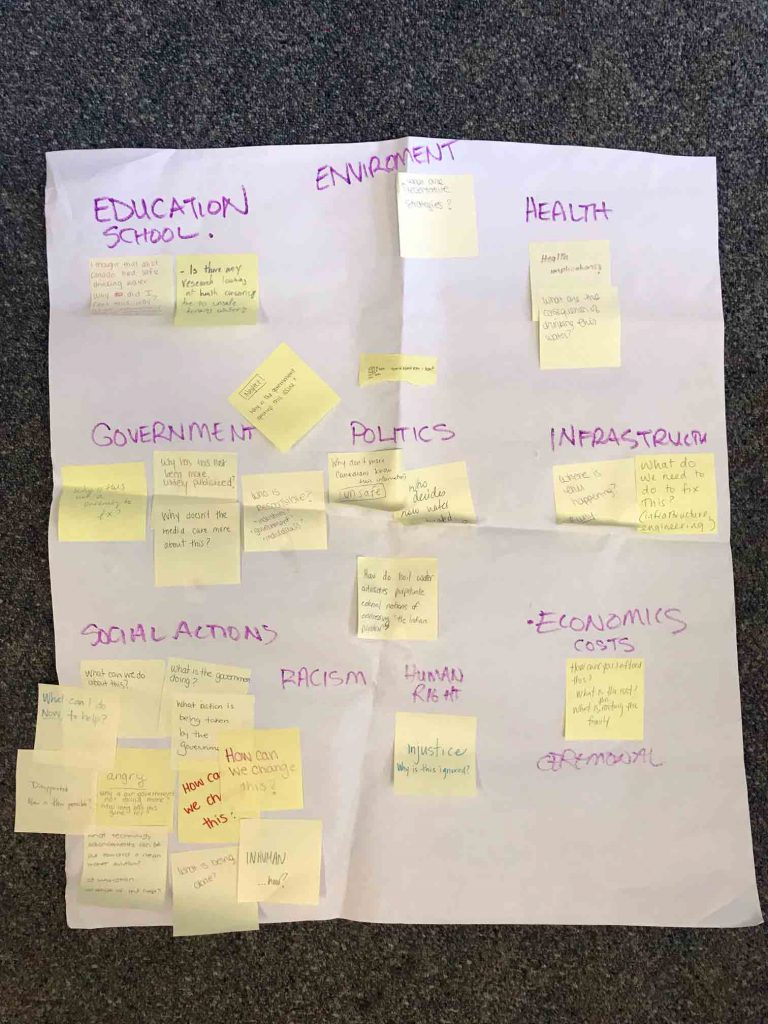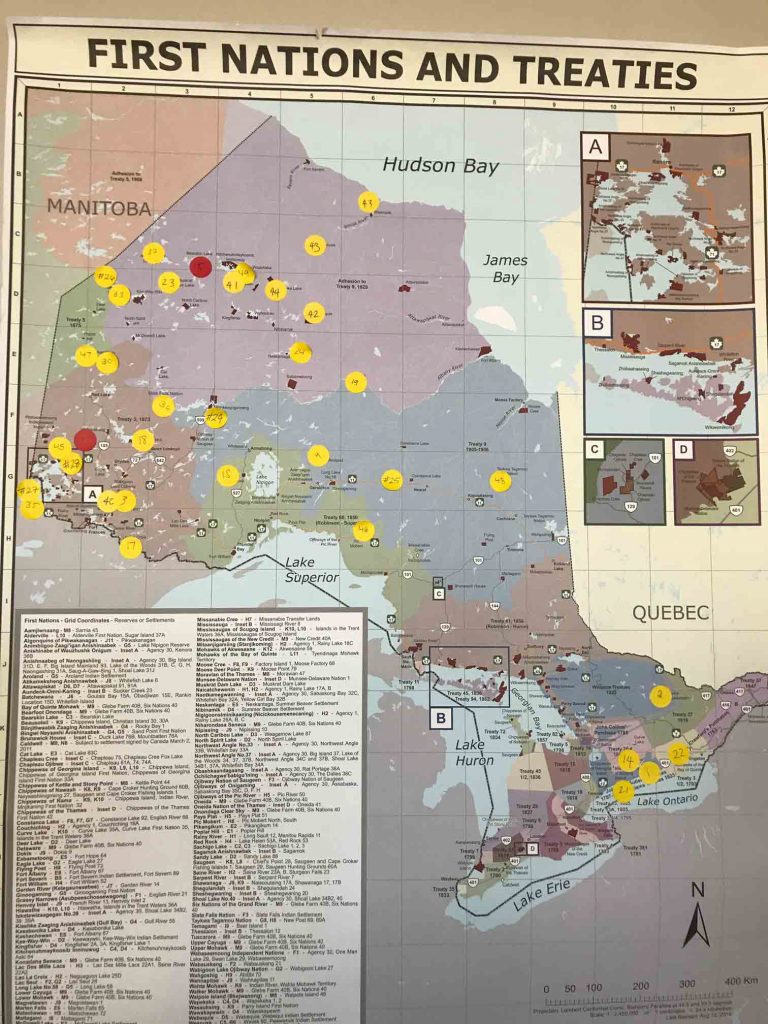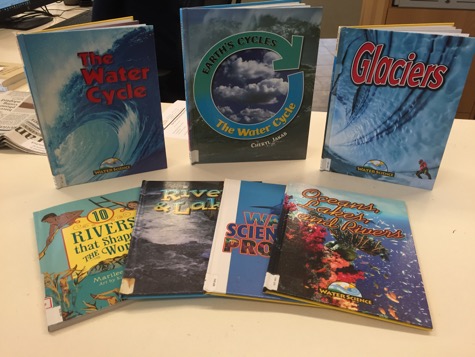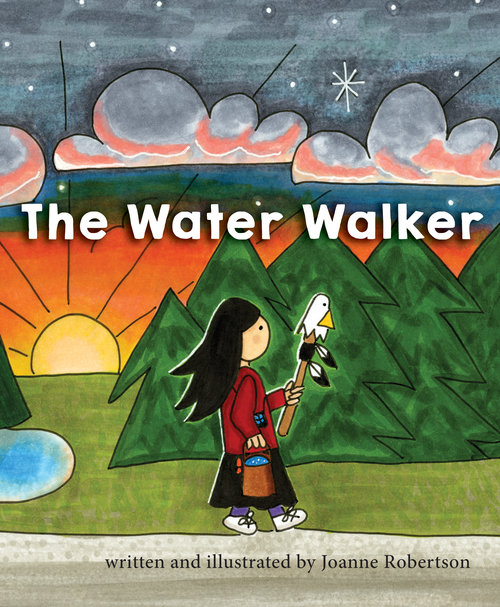- Put students into working groups according to their areas of interest (through their questions). Begin researching their area of interest. Gather as a class for discussions or knowledge building circles to share findings. Groups can display their findings prominently in the classroom.
- Teaching children how to “take action” on issues of social justice is an important aspect of informed citizenship. Brainstorm ways in which research groups can make their “finding” public (e.g., creating posters or public service announcements, writing blogs, creating podcasts, documentaries, letters to the editor of local newspapers, etc.)
- Use sticky notes to create a group poem
- Provide additional information about drinking water advisories for First Nation Communities in Ontario. For example, show YouTube videos such as those by HumanRightsWatch (2016) for firsthand accounts of people’s experiences with boil water advisories.
Studying Water: Integrating Inquiry-Based Math, Science, Mapping and Social Justice
Junior (Age 9 – 12)
This inquiry-based, water-focused lesson integrates mathematics, environmental science, geography, Indigenous rights, language arts and social justice issues. It was designed to model how inquiry might look in the junior and intermediate grades. It is also an example of how to use mathematics to explore issues of social justice. This lesson has sparked inquiry with groups of teachers during PD as well as with junior and intermediate students in a variety of classrooms. Dr. Bev Caswell developed the lesson in response to the realization that a disproportionate number of First Nation communities experience boil water advisories when compared to the rest of Canada. It appears in the second edition of Natural Curiosity.
“Can you imagine parents, teachers, or the general public in major cities in Canada putting up with this in their schools for weeks let alone years on end?” Caswell says. “Why is there no public outrage on this pressing issue?”
Part 1: Water Connections
Materials
- PowerPoint presentation
- BLM: Anishinaabemowin Water Words
- Computers with Internet access
- Projector
Activity Overview
- Begin the lesson by reading the following excerpt: “Could I ask you to shut your eyes. Now, open your minds. With eyes closed, look down, down through the surface veneer beneath your feet, past the floor joists and structural shadows, look down until you see the earth. The building disappears, and you are a witness, but time has collapsed and you are not here. Look around you. At first you see forest, great pines and rich flora, then you see water, a riverbank and you hear the sound of fish swimming and butterfly wings – that’s how attuned you are to your surroundings, how inseparable you are from the natural world.”
– An excerpt from: “The opposite of Prayer: Introduction of Tomson Highway” by John Moss in Comparing Mythologies by Tomson Highway. - Give everyone time to write words on sticky notes that come to mind when they think of water. One word per sticky note. Provide time for each student to read the words aloud.
- Ask entire group: “Think about an experience you’ve had that has connected you to water in some way (for example, it could have to do with oceans, lakes, storms, rain, drinking water, tides, floods, canoeing, camping, swimming, etc.).” Talk in table groups or in pairs about experiences. Ask 3-4 students to share their experiences with the entire group.
- Introduce the importance of water in our lives: Ask students to share cultural or religious practices related to water (eg. ritual washing). Share link to Anishinaabe cultural practices (Water Walks) relating to water:
• Liz Osawamick’s water song - Share words that relate to water in various languages.


Watch Liz Osawamick share her Water Song with The Robertson Program
Part 2: Math Explorations – Central Tendency & Capacity
Materials
- White board & Marker
- 1 Litre water bottle (one per group)
- Dimensions of bathtub (122cm x 81cm x 64cm)
- BLM: How much water do you use in one week?
- 1 Litre water bottle (one per group)
- Computers with Internet access
Activity Overview
- Ask table groups to brainstorm ways in which they use water in their lives. Hear from each group. Create list.
- When students mentions bath/shower, hold up a 1 Litre water bottle and ask groups to: Estimate how many bottles of water you think it would take to fill bath tub. Document the estimates on board at front of room. Have the students put the numbers in order. Give a mini lesson on mean, median, and mode using these numbers. Highlight various strategies students use.
- Give each group a 1 L bottle. Ask them to think about how they might calculate the capacity of a bath tub. What information do we need to calculate the capacity? Give time for students to revise their estimates now that they have tub measurements. After groups have shared their ideas, you may decide to introduce the formula for calculating volume.
- Ask students: Approximately how much water do you consume weekly?
- Distribute BLM: How much water do you use in a week?
- Ask everyone to use the worksheet to calculate approximate number of litres of water used per week.
- Invite groups to write these numbers on board at front of the room and/or find the average for each table group then write the numbers on the board.
- Discuss water consumption – Any surprises?
- For further exploration, visit the CBC Water calculator.
Part 3: Introduction to Drinking Water Advisories
Materials
- Sticky notes and pen
- Chart paper and markers
Activity Overview
- Introduce the following statement: “Nearly half of the 133 First Nations in Ontario currently have boil water advisories, and it has been more than ten years since ten First Nations in Northwestern Ontario had clean drinking water (Porter, 2014)
* This number will hopefully change as the Canadian government fulfills its commitment of no boiled water advisories by 2020. - Invite students to think about the statement above and to use the sticky notes provided to write one word that comes to mind. Ask students to read their words. These can be collected for later use in a language arts activity (e.g., performance piece or poetry to raise awareness of issues).
- Now ask students to use the stickies to write any questions, thoughts that come to mind, or emotions that arise as they think about this fact. Give time for students to write questions – remind them to use a separate sticky note for each question or response
- Distribute chart paper and markers and invite table groups to sort the sticky notes into categories.
- Each table will share the way they categorized their questions (possible categories: sources of water pollution; legislation; engineering systems to clean water, etc.)
- Discuss ways in which we might go about answering our questions.
- Students can choose a specific area of interest to study. Discuss ways we might go about answering our questions.

Participants share ideas and sort through them using sticky notes
Mapping Drinking Water Advisories
Materials
- Communities Under Drinking Water Advisory
- Roadmap of Ontario (one per group)
- Circle Stickers: red, orange, green, blue
- Large First Nation Maps of Ontario
- Same map but smaller versions in plastic sleeves
Activity Overview
- Give each group a list of the names of First Nation communities in Ontario that are under boil water advisories (BLM: First Nations Drinking Water Advisory)
- Divide up the list and assign an equal number of First Nation communities on the list to each table group.
- Distribute a roadmap of Ontario to each table groups.
- Ask groups to act as cartographers and investigative journalists to locate each of the FN communities and write the names of these communities on their roadmaps. Then place a colour coded sticker on the map and write a number to identify the particular community.
- red = do not drink the water
- orange = boil water advisory
- green = algae blooms
- blue = water shortage
*Note: You can have a couple of large First Nation Maps of Ontario to help them locate the First Nation communities or the smaller versions at each table. Alternatively, students can use their computers or phones to locate the communities in the list.
- At the front of the room, hang the large version of the First Nation Map of Ontario. Ask groups to: Place colour-coded stickers on the large map to represent various types and numbers of drinking water advisories First Nation Communities in Ontario.
- Invite students to discuss: “When you look at the map, what do you think?“
- Hand out sources of information about drinking water advisories for First Nation Communities in Ontario.

Participants label a map of First Nation communities currently under a water boil advisory
Next Steps in an Inquiry
Invite participants to view map. Ask students the following:
What do you think? What observations do you have? Any further questions to add to our lists?
Categorizing questions:
- Which questions can be answered quite quickly?
- Which questions are going to take more time?
- Which are the burning questions?
Have students write these on construction paper and place them on an “inquiry board” in the classroom.

Water-related books that can be used to further your inquiry
Inquiry Ideas

The Water Walker by Joanne Robertson
Math refreshers for teachers
What is volume?
It is a word that can have several meanings, such as a number in a series of books; but in terms of measurement, we are looking at how much space an object or liquid occupies. For example, if I have a tank, how much space does it take up?
How to find the volume of prisms:
To find the volume of prism, you have to find the product of the area of the base and the height. For example, if you have a tank with the following dimensions: 50cm (L) x 40cm (W) x 30cm (H), the area of the base is 50cm x 40cm = 2000cm2 . Then you would multiple the base area by the height: 2000cm2 x 30cm = 60 000cm3 . Since 1cm3 = 1mL, 60 000cm3 = 60 000mL. And since 1000mL = 1L, 60 000mL = 60L.
Units of volume:
Volume is measured using L (litres), mL (millilitres), m3 (cubic metre), and cm3 (cubic centimetre).
1cm3 = 1mL
1,000,000 cm3 = 1m3
1000 mL = 1L
1000 L = 1m3
Why is 1 000 000cm3 = 1m3 ?
1m3 = 1m x 1m x 1m
1m3 = 100cm x 100cm x 100cm
1m3 = 1 000 000 cm3
